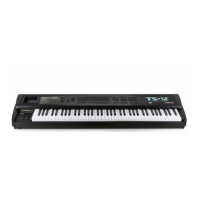Section 7 — Effect Parameters TS-12 Musician’s Manual
20
DEFINITION Range: 00 to 99
Controls the rate at which echo density increases with time. Higher values can cause the echo
density to build at a rate that exceeds the decay rate. For the best performance, try to select the
highest value that works with your sound source.
DIFFUSION Ranges: 00 to 99
These parameters determine whether the early reflections will appear as a series of discrete
echoes (lower values) or will be more diffused (higher values).
49 EQ- -CHORUS + REVERB
This algorithm offers a serial version of the PARAM EQ+CHORUS+REV parallel effect. The
second sub-page (not user-programmable) shows how this effect is routed:
• Voices assigned to FX1 are sent to Effect A (PARAM EQ)
• The output of Effect A is sent to Effect B (CHORUS)
• Voices assigned to FX2 are sent to the reverb (REV)
For a complete description of the SENDS parameters, refer to the DDL- -CHORUS + REVRB 1
algorithm found earlier in this section.
INPUT Range: 00 to 99
Allows you to adjust the input level trim to the EQs to eliminate the possibility of clipping
boosted signals.
OUTPUT Range: 00 to 99
Adjusts the output volume after the parametric EQ. With the LEVEL, BASS LEVEL, and TREBLE
LEVEL set to high values, the OUTPUT parameter could be used to create a raspy distortion
effect.
PAN Range: -99 to +99
Determines the location of the EQ in the stereo spectrum. A value of -99 is panned hard left, and
+99 is hard right.
MID FC Range: 00000 to 15000
Sets the center of the mid-frequency parametric.
BW Range: 0 to 15K
This parameter is a bandwidth control that determines the width of the resonant peak at the mid-
frequency band. By lowering the value, you can produce a narrower bandwidth.
LEVEL Range: -99 to +48 dB
Sets the amount of boost or cut applied to this mid-frequency parametric.
BASS LEVEL Range: -99 to +48 dB
Sets the amount of boost or cut applied to a 0 to 80Hz low-shelving filter.
TREBLE LEVEL Range: -99 to +48 dB
Sets the amount of boost or cut applied to a 10 to 15K high-shelving filter.
For a complete description of the remaining parameters, refer to the DDL+CHORUS+REV
algorithm found earlier in this section.

